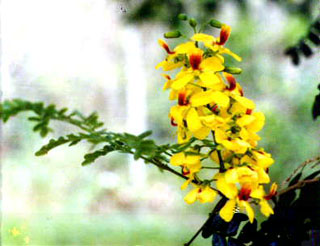Human Flower Project
Tuesday, July 25, 2006
Pernambuco: Play On!
Bowmakers, environmentalists and now musicians too are orchestrating conservation of the pau brasil tree.

Pernambuco nursery
Photo: IPCI
Thank you, Margaret Adie, for introducing us to the most melodious of flowering plants: Caesalpinia echinata, the pernambuco tree of Brazil’s Atlantic forest.
A bowmaker by trade, Margaret extols the strength, flexibility and beauty of pernambuco (A.K.A. pau brazil). Its slow growing heartwood has been favored for “fiddlesticks” since the 19th century, with a top quality new bow of the native Brazilian tree starting at about $2000. Margaret tells us that a fine old bow “can sell for up to
$50,000.”
![]()
Viola bow, pernambuco wood with silver mountings
Photo: Lynn Armour Hannings
It may not be long, however, before one won’t be able to find a pernambuco bow at any price. 90% of the Mata Atlantica, or Brazilian Atlantic forest, has been cut. For three hundred years, beginning in the 16th century, pernambuco trees were harvested and shipped east for the European dye trade. Then in the mid 19th century, the Tourte brothers of France discovered that pernambuco was heaven-sent material for violin, viola and cello bows. Ever since, bowmakers in Brazil and across the world have scrambled to get their hands on the precious orangey heartwood.
In the past ten years, with increased deforestation of the Mata Atlantic, craftspeople have faced the music. Bowmakers and musicians from eighteen countries have become ecologists through the International Pernambuco Conservation Initiative. With the real possibility of pernambuco’s extinction within earshot, they’re coming together to promote sustainable use of this precious resource and generate stands of pau brasil for the future.
 Caesalpinia echinata in bloom
Caesalpinia echinata in bloom
Photo: Ad Naturam
Living on Earth aired a good radio piece on this subject. Brazilian bloggers have sounded the alarm. Check out bowmaker Lynn Armour Hanning’s site with beautiful cards of pernambuco blossoms for sale, as well as pointers on how to go about choosing a bow.
We are, of course, drawn by the lovely pernambuco blossoms, fragrant and bright yellow “with a blood red blotch.” It takes 3-4 years before pau brasil plants begin blooming, the blossoms lasting only a day or two. Pernambuco trees not only produce flowers, they wear them, hosting orchids and other epiphytes.
Again, thank you, Margaret, for information and inspiration. May the pernambuco play on.




